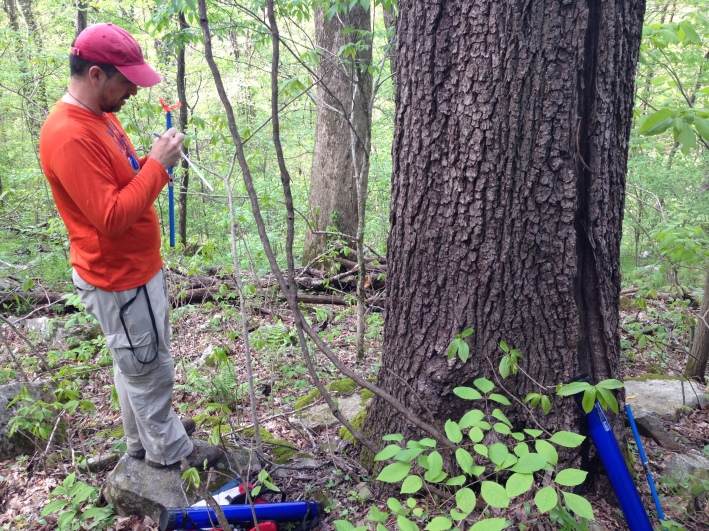
Javier Martin Fernandez collecting a sample of black walnut (Juglans nigra) in eastern Oklahoma. The large tree in the background is a cucumber Magnolia (Magnolia acuminata).
Sponsored by the Climate Center of Lamont-Doherty Earth Observatory and led by A. Park Williams, we have begun a project based on Park’s 2010 paper indicating that the forest ecotone in the Southern Plains and mid Mississippi River Valley region might be one of the most vulnerable to global warming.
Phase I fieldwork is complete!

We hit eastern Oklahoma at Peak Spring at the beginning of one of the wettest late-springs in recorded history. Talimena Scenic Drive, Oklahoma, April 2013.
Project Abstract:
Meta-analyses of tree-ring and climate data indicate that forests may exhibit a stronger negative growth response to summer temperatures in the southern-central United States (U.S.) than in any other region in the Northern Hemisphere. It is unclear how representative these results are of all forests in the region, however, because these results are based upon a potentially non-representative set of tree-ring samples. Importantly, this region did not warm over the past century, but climate models project rapid 21st century warming such that the average summer by the 2050s is warmer than the warmest summer during 1895–2013. The negative response of trees to warmth most likely reflects a negative response to drought, and climate models project rapid warming to intensify drought in the east and central U.S., even in the case of increased precipitation. We propose to conduct tree-ring sampling and remote-sensing investigations along a regional moisture gradient from the relatively wet interior of eastern broadleaf forest habitat to the relatively dry western edge of this range to learn about the heat sensitivity, and ultimately, the future of forests in the grassland-to-forest transition zone of the southern-central U.S. A warming-induced eastward migration of this transition zone could have climate feedbacks on much of eastern North America, making our proposed research a high-impact and cross-disciplinary activity with
strong potential for follow-on funding.
